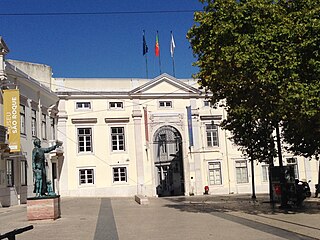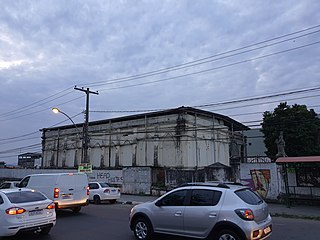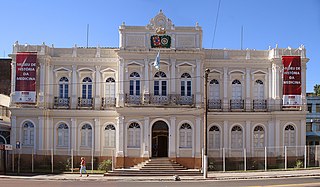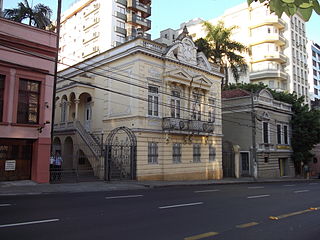
Porto Alegre is the capital and largest city of the Brazilian state of Rio Grande do Sul. Its population of 1.3 million inhabitants (2022) makes it the 11th-most populous city in the country and the center of Brazil's fifth-largest metropolitan area, with 4.4 million inhabitants (2010). The city is the southernmost capital city of a Brazilian state.

Santos, officially Municipality of Estância Balneária de Santos, is a municipality in the Brazilian state of São Paulo, founded in 1546 by the Portuguese nobleman Brás Cubas. It is located mostly on the island of São Vicente, which harbors both the city of Santos and the city of São Vicente, and partially on the mainland. It is the main city in the metropolitan region of Baixada Santista. The population is 433,656 in an area of 280.67 km2 (108.37 sq mi). The city is home to the Coffee Museum, where world coffee prices were once negotiated. There is also a football memorial, dedicated to the city's greatest players, which includes Pelé, who spent the majority of his career with Santos Futebol Clube. Its beachfront garden, 5,335 m (5,834 yd) in length, figures in Guinness World Records as the largest beachfront garden in the world.

The Federal University of Rio Grande do Sul is a Brazilian public federal research university based in Porto Alegre, Rio Grande do Sul. UFRGS is among the largest and highest-rated universities in Brazil, having one of the largest number of scientific publications. From 2012 to 2019, the university was elected as the best federal university of Brazil. UFRGS has over 31,000 undergraduate students, over 12,000 graduate students, and more than 2,600 faculty members. As a Brazilian public federal institution, students do not pay tuition fees to enroll in courses offered by the university.

Vila de São Sebastião, commonly shortened to São Sebastião, is a civil parish in the municipality of Angra do Heroísmo, on the island of Terceira in the Portuguese archipelago of the Azores. The population in 2011 was 2,096, in an area of 23.93 square kilometres (9.24 sq mi). It is in the southeastern part of the island of Terceira. It contains the localities Arrabalde, Boavista, Cavalas, Canada da Salga, Contendas, Cruz, Maria Vieira, Ribeira Seca de Cima, Ribeira Seca de Baixo, Salgueiros and Vila de São Sebastião.

The Federal University of Health Sciences of Porto Alegre, formerly known as Fundação Faculdade Federal de Ciências Médicas de Porto Alegre and Faculdade Católica de Medicina de Porto Alegre, is a federal institution of higher education and research on health sciences located in Porto Alegre, Brazil.

Júlio de Castilhos Museum is a museum located in the city of Porto Alegre. It is the oldest museum in Rio Grande do Sul state.

Santa Casa da Misericórdia is a lay Portuguese charity founded in 1498, whose mission is to treat and support the sick, the disabled, as well as abandoned newborns.

Rita Lobato Velho Lopes was the first woman to earn a degree in Brazil to practice medicine. She was the second Brazilian woman physician, following Maria Augusta Generoso Estrela, who earned a degree from the New York Medical College and Hospital for Women in 1881. Lobato received her degree in 1887 from a school in Bahia. Her initial enrollment caused debate, with some people arguing that women had brains too small to understand medicine or that a female doctor would never find a husband, although others were in favor of her entrance and the Echo das Damas saw her as an example for Brazilian girls. She did, in fact, marry and practised medicine for several years.

Centro Histórico is a neighborhood of the city of Porto Alegre, the state capital of Rio Grande do Sul in Brazil.

Santa Cecília is a neighbourhood (bairro) in the city of Porto Alegre, the state capital of Rio Grande do Sul, Brazil. It was created by Law 2022 from December 7, 1959.

A Church of the Santa Casa da Misericórdia, sometime referred to as the Church of Our Lady of Mercy, is a 17th-century church in the civil parish of Penafiel, in the municipality of the same name, in the Portuguese district of Porto.

The Santa Casa de Misericórdia of Santo Amaro is an 18th-century philanthropic and medical building in Santo Amaro, Bahia, Brazil. The building was completed in 1778, following the construction of the Parish Church of Our Lady of Purification and the Town Hall of Santo Amaro (1769). The Santa Casa de Misericórdia of Santo Amaro faces the Parish Church of Our Lady of Purification in the Historic Center of Santo Amaro. The building contains the Hospital Nossa Senhora da Natividade and still functions as a hospital in Santo Amaro.

The Church and Santa Casa da Misericórdia is a former church and hospital in Salvador, Bahia, Brazil. It was established as a branch of the Santa Casa da Misericórdia in 1549; a hospital, Hospital da Caridade, functioned from the 17th century. The Santa Casa additionally held a monopoly on burials in colonial Bahia. It was additionally funded by its brotherhood, the Brotherhood of Santa Casa. The Santa Casa of Bahia accepted the donation of a slave-holding plantation, the Fazenda Saubara in present-day Saubara, in 1652. The former hospital and chapel now functions as a museum, the Misericórdia Museum. The Santa Casa, apart from the museum, now owns and operates the Santa Izabel Hospital, the Santa Casa Medical Faculty, the Jorge Calmon Memory Center, Campo Santo Cemetery, an events space, and numerous historic buildings in Salvador.

The Building of the Santa Casa de Misericórdia of Feira de Santana is an 18th-century mansion and medical building in Feira de Santana, Bahia, Brazil. It was established in the Portuguese colonial period as a branch of the Santa Casa da Misericórdia, a lay Portuguese organization to treat the sick and disabled. The building was listed as a state heritage site by the Institute of Artistic and Cultural Heritage of Bahia in 2008.

The Beneficência Portuguesa de Porto Alegre, originally Sociedade Beneficente e Hospitalar da Colônia Portuguesa de Porto Alegre, is a Brazilian philanthropic hospital institution in the city of Porto Alegre, state of Rio Grande do Sul.

Independência Avenue is an important road in the Brazilian city of Porto Alegre, capital of the state of Rio Grande do Sul. It is the main axis of the Independência neighborhood. It starts at Dom Feliciano Square, in the historic center of the city, and ends at Mostardeiro Street, in the Independência neighborhood, as a continuation of the Rua da Praia.

The Nosso Senhor dos Passos Chapel is a Catholic temple located in the Brazilian city of Porto Alegre, part of the Santa Casa de Misericórdia building complex. It has been included in the city's historical heritage.


















